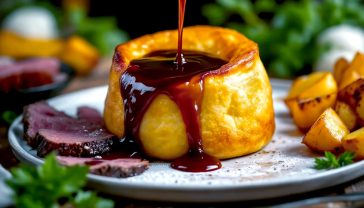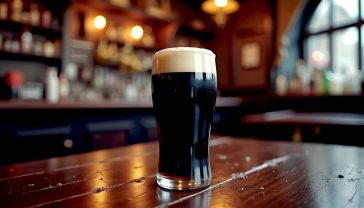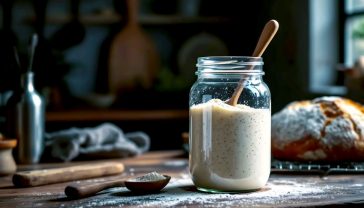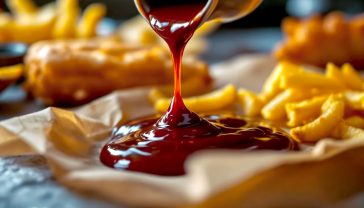From Barley to Brew: The Unmissable Story of Britain’s Beloved Ales
Your ultimate guide to how Britain’s beloved ales are made. We break down every step, from ingredients and malting to fermentation and serving in the pub.

This post may contain affiliate links. If you make a purchase through these links, we may earn a commission at no additional cost to you.
There’s a unique magic to a proper British pub. It’s in the low hum of conversation, the clink of glasses, and the rich, malty aroma that hangs in the air. At the heart of it all is a pint of ale—a drink that’s as much a part of our national identity as a Sunday roast or a rainy bank holiday. But have you ever stopped to wonder what’s actually in that glass? How does a humble field of barley transform into the complex, comforting drink we call ale?
It’s not witchcraft, though it can feel like it. It’s a beautiful, centuries-old process that blends agriculture, science, and artistry. It’s a story of sleepy grains being woken up, of tiny organisms doing a mighty job, and of a delicate balance of flavours that brewers work tirelessly to perfect.
Forget the complicated jargon for a moment. Think of this as a journey. We’re going to follow the path from a single grain of barley all the way to the freshly pulled pint in your hand. Whether you’re a seasoned ale enthusiast or just curious about what makes a Bitter different from a Mild, this guide will explain everything. So, grab a comfy chair, and let’s dive into the wonderful world of brewing Britain’s beloved ales.
The Holy Trinity (Plus One): The Core Ingredients of Ale
Before we step onto the brewery floor, we need to meet the key players. Almost all the beer in the world is made from four simple ingredients. But it’s how British brewers use them that creates the unique character of our ales.
Malted Barley: The Soul of the Beer
If ale were a loaf of bread, malted barley would be the flour. It’s the absolute backbone of the beer, providing the sugars that will eventually become alcohol, as well as the drink’s colour and its core malty, biscuit-like flavours.
- A Simple Analogy: Think of malted barley as the beer’s engine and its bodywork all in one. It provides the fuel (sugar) for the journey and determines whether the final car is a sleek, pale sports car or a rich, dark estate.
- The Detail: Brewers don’t just use any old barley. They use specific varieties, like the famous Maris Otter, which is prized for the rich, delicious flavour it gives to beer. But you can’t just chuck barley grains into water and hope for the best. They first have to be ‘malted’. This is a crucial process (which we’ll cover in a moment) that tricks the grain into starting to grow, unlocking the starches and enzymes hidden inside. The barley is then toasted in a kiln. A light toasting gives you pale malt for golden ales, while a heavier toasting creates darker, caramelised crystal malts or even intensely roasted chocolate and black malts for stouts and porters.
Hops: The Spice and Spirit
If malt is the bread, then hops are the seasoning. These little green, cone-shaped flowers are responsible for the bitterness that balances the malt’s sweetness, as well as the wonderful aromas of citrus, pine, flowers, and spice you find in many ales.
- A Simple Analogy: Hops are to brewers what a spice rack is to a chef. A pinch of one type adds a zesty, bitter kick, while another might add a lovely floral smell. Without them, ale would be a sickly sweet, sludgy mess.
- The Detail: Hops contain oils and acids. The alpha acids provide bitterness when boiled. The longer you boil them, the more bitter the beer becomes. The essential oils are much more delicate and provide aroma. To preserve these, brewers often add ‘aroma hops’ right at the end of the boil or even after the beer has fermented (a technique called ‘dry hopping’). Britain has its own classic hop varieties, like Fuggles and East Kent Goldings, known for their earthy, spicy, and subtly floral notes, which are the hallmark of a traditional British Bitter.
Yeast: The Unseen Alchemist
This is where the real magic happens. Yeast is a microscopic, single-celled fungus. It’s a tiny, living organism that eats sugar and, in return, produces two very important things: alcohol and carbon dioxide (the bubbles).
- A Simple Analogy: Think of yeast as a team of microscopic chefs. The brewer makes a sweet, sugary liquid, and the yeast gets to work, gobbling it all up and transforming it into a delicious, bubbly, and alcoholic final dish.
- The Detail: The specific strain of yeast used for making ale is called Saccharomyces cerevisiae. It’s known as a ‘top-fermenting’ yeast because it tends to form a thick, foamy layer on top of the beer as it works. Different yeast strains produce different flavours. Some create fruity notes of banana, pear, or apple, known as esters. Others might produce spicy, clove-like notes, known as phenols. The brewer’s choice of yeast is just as important as their choice of malt or hops in defining the final character of the ale.
The Fourth Element: Britain’s Secret Weapon – Water
You might think water is just… water. But in brewing, it’s the canvas on which all the other flavours are painted. The minerals dissolved in the water can have a massive impact on the taste of a beer.
- A Simple Analogy: If brewing is like painting a picture, water is the canvas. A smooth, plain canvas is different from a rough, textured one. Each gives a different character to the final artwork.
- The Detail: The town of Burton-on-Trent became world-famous for brewing Pale Ales for a reason. Its local water is very hard, rich in a mineral called calcium sulphate (gypsum). This mineral has a fantastic ability to accentuate the crisp bitterness of hops and create a dry, refreshing finish. Brewers in other parts of the country, like London, had softer water, which was perfect for brewing dark, malty beers like Porter. Today, modern brewers don’t leave this to chance. They treat their water, adding or removing minerals to create the perfect profile for the style of ale they want to brew. This is often called ‘Burtonisation’ in honour of the original pioneers.
The Brewery Floor: A Step-by-Step Guide to Making Ale
Now we’ve met the ingredients, let’s see how they come together. The brewing process can be broken down into seven key steps.
Step 1: Malting – Waking Up the Barley
As we mentioned, barley straight from the field isn’t ready for brewing. It needs to be malted first. While most brewers buy their malt from a specialist malthouse, it’s the essential first step in our journey.
- The Simple Version: The barley grains are soaked in water to trick them into thinking it’s springtime and time to grow. Just as they start to sprout, they’re heated and dried in a kiln. This process unlocks the food stores (starch) inside the grain and develops the enzymes the brewer will need later.
- The Nitty-Gritty: The process has three stages. First is steeping, where grains are soaked for a couple of days. Next is germination, where they’re left in a warm, damp place to start sprouting. This creates crucial enzymes, particularly amylase, which acts like a pair of molecular scissors. Finally, there’s kilning. The sprouted grains are heated to stop the growing process. The temperature and duration of kilning determine the malt’s character—from lightly kilned Pale Malt to darker Crystal and Chocolate Malts.
Step 2: Milling and Mashing – The Great British Porridge
This is where the brewer’s day really begins. The aim here is simple: to extract the sugars from the malted barley.
- The Simple Version: The dried malt grains are cracked open in a mill. This crushed grain, called ‘grist’, is then mixed with hot water in a big vessel called a mash tun. It’s basically like making a giant, oaty porridge. The hot water allows the enzymes we activated during malting to get to work, chopping up the grain’s starch into sugary goodness.
- The Nitty-Gritty: The milling is important; the husks need to be kept mostly intact, but the starchy centre must be crushed. In the mash tun, the grist is mixed with hot water (a process called ‘mashing in’) and left to sit for about an hour at a very specific temperature, usually between 65-68°C. This is the sweet spot for those amylase enzymes to convert long starch chains into smaller, fermentable sugars like maltose. The result is a thick, sweet, porridge-like mixture called the mash.
Step 3: Lautering and Sparging – Rinsing for Sweetness
Once the mash is done, we have a porridge full of sugary liquid, but it’s mixed in with all the solid grain husks. The next job is to separate the two.
- The Simple Version: The sweet liquid is drained from the bottom of the mash tun. The bed of grains cleverly acts as a natural filter. Then, the brewer rinses the remaining grains with more hot water to wash off every last bit of sugar, a bit like rinsing a teabag to get a stronger cuppa.
- The Nitty-Gritty: This stage is called lautering. The first liquid that’s drained off is often recirculated over the top of the grain bed to help clear it up. Once it’s running clear, it’s drained away. This super-sweet, malty liquid is now called wort (pronounced ‘wert’). Then comes sparging, which is the rinsing process. Hot water is gently sprinkled over the grain bed to extract the remaining sugars. The brewer carefully monitors the sugar concentration of the liquid coming out to know when to stop.
Step 4: The Boil – A Bubbling Cauldron of Flavour
The wort is collected in a giant kettle, known as a copper (even though most are stainless steel these days). Now it’s time for a good, vigorous boil. This is a vital step for several reasons.
- The Simple Version: The sugary wort is boiled for about an hour. This is when the hops are added. Boiling sterilises the liquid, gets rid of unwanted compounds, and extracts the bitterness from the hops.
- The Nitty-Gritty: The boil typically lasts 60 to 90 minutes. Its main jobs are:
- Sterilisation: It kills any stray bacteria or wild yeast that could spoil the beer.
- Isomerisation: This is a fancy word for what happens to the hops. The heat chemically changes the alpha acids, making them soluble in the wort and giving the beer its bitterness. Bittering hops are added at the start of the boil for this reason.
- Flavour Development: The heat can cause some caramelisation of the wort, adding to the beer’s complexity.
- Aroma: Aroma hops, with their delicate oils, are often added in the last 5-15 minutes of the boil, or even after the heat is turned off, to preserve their fragrant character.
- The Hot Break: During the boil, proteins in the wort clump together and fall out of the solution. This is called the ‘hot break’, and it helps create a clearer final beer.
Step 5: Cooling and Pitching – Preparing for Fermentation
After an hour of frantic boiling, we have a hot, bitter, and sweet wort. But it’s far too hot for our yeast to survive. We need to cool it down, and fast.
- The Simple Version: The boiling hot wort is quickly chilled down to room temperature. Once it’s cool enough, the yeast is added (or ‘pitched’).
- The Nitty-Gritty: The wort is usually passed through a heat exchanger, a clever bit of kit where the hot wort flows past pipes containing cold water, transferring its heat without the two liquids ever touching. It needs to be cooled to the ideal temperature for ale yeast, which is typically 18-22°C. Cooling it quickly is important to prevent contamination from airborne bacteria while the wort is vulnerable. Once cooled, the wort is transferred to a fermentation vessel, and the brewer pitches the yeast. Oxygen is often added at this stage, as yeast needs a bit of it to multiply and get strong before it starts the hard work of fermentation.
Step 6: Fermentation – Where the Magic Happens
This is the quietest but most transformative part of the process. The brewer has done their job; now it’s over to the yeast.
- The Simple Version: The fermentation tank is sealed, and the yeast gets to work. Over the next few days to a week, it eats all the sugar in the wort and turns it into alcohol and CO2 gas. You can often see a thick, bubbly foam on top as the yeast does its thing.
- The Nitty-Gritty: During primary fermentation, the yeast goes through a massive growth phase. A thick, rocky head of foam, called a krausen, forms on the top of the beer. This is characteristic of top-fermenting ale yeast. The yeast diligently metabolises the sugars, producing ethanol (alcohol) and CO2. It also produces those flavourful esters and phenols that give different ales their unique fruity or spicy character. The brewer monitors the temperature closely, as a few degrees difference can dramatically change the flavour profile. They also measure the beer’s density (or ‘gravity’) to track how much sugar the yeast has consumed.
Step 7: Conditioning – Letting the Beer Mature
The main fermentation might be over, but the beer isn’t quite ready yet. It’s now what we call ‘green beer’—it’s alcoholic, but the flavours are still a bit rough and unbalanced. It needs time to mature and mellow out. This is the conditioning phase.
- The Simple Version: The young beer is moved to a new tank (or a cask) and left in a cool place for a while. This allows the flavours to soften and meld together, and for the beer to clear up.
- The Nitty-Gritty: The beer is often racked (transferred) off the thick layer of dormant yeast and other sediment at the bottom of the fermenter. This conditioning period can last from a few days to several weeks. During this time, any remaining yeast will clean up some of the harsher flavour compounds produced during fermentation. The beer will become clearer as yeast and proteins slowly settle out. This is also the stage where a brewer might dry hop the beer, adding hops directly to the conditioning tank to impart a fresh, vibrant hop aroma without adding any more bitterness.
From Cellar to Glass: Serving Britain’s Finest
The brewing is done, but the final part of the journey is just as important: getting it into your glass in perfect condition. In Britain, there are two main paths an ale can take.
Cask Ale: The Art of “Real Ale”
This is the traditional method, championed by the Campaign for Real Ale (CAMRA). It’s a uniquely British institution.
- The Simple Version: Cask ale is ‘living beer’. After conditioning, it’s put into a metal cask with a little bit of yeast and sugar still in it. This allows it to have a gentle second fermentation inside the cask in the pub’s cellar. It’s served without any extra gas, using a hand-pulled pump, giving it a soft, gentle carbonation.
- The Detail: The beer that goes into the cask is still active. Often, finings (traditionally, a substance called isinglass, made from fish swim bladders) are added, which help pull the yeast down to the bottom of the cask, leaving the beer brilliantly clear. The publican then has the crucial job of tapping the cask and letting it condition in the cellar for a few days. The beer develops its carbonation naturally. When served via a beer engine (the handpump), it has a much lower level of fizz than keg beers, allowing the subtle malt and hop flavours to shine through. Some pumps in the North of England have a ‘sparkler’ on the nozzle, which forces the beer through tiny holes, giving it a thicker, creamier head.
Keg and Bottle: Consistency and Convenience
The other common method is kegging. This is what most lagers, ciders, and many modern ‘craft’ ales are served from.
- The Simple Version: This beer is filtered bright and is no longer ‘living’. It’s put into a sealed keg and has carbon dioxide forced into it to make it fizzy. It’s then pushed from the keg to the tap using gas pressure.
- The Detail: Before kegging, the beer is often chilled and filtered to remove all the yeast. It might also be pasteurised (heated) to ensure its stability. This means the beer is consistent and has a much longer shelf life than cask ale. Carbon dioxide (or sometimes a mix of CO2 and nitrogen for a creamier head, like in Guinness) is used to force it to the tap. While some purists look down on keg beer, the rise of the craft beer scene has seen many brewers put fantastic, flavourful, and unpasteurised ales into kegs to preserve their hop-forward character.
A Pint-Sized History of British Ale
You can’t talk about ale without a nod to its history. People have been brewing in Britain for thousands of years. Early ales were often thick, nutritious, and a safer alternative to dirty water.
The pub as we know it began to emerge from Roman taverns and Anglo-Saxon alehouses. In the 18th century, London brewers invented Porter, a dark, robust beer that became the first truly mass-produced style. In the 19th century, brewers in Burton-on-Trent used their unique water to create the bright, hoppy Pale Ales that would conquer the world, including the heavily-hopped version—India Pale Ale (IPA)—designed to survive the long sea voyage to the British colonies.
After the Second World War, big breweries began to dominate, pushing mass-produced, fizzy keg beers that were easy to serve. Many felt the traditional cask ale was dying out. In response, four friends formed CAMRA in 1971 to protect and promote ‘real ale’. Their campaign was a massive success, and it’s largely thanks to them that we still have such a vibrant cask ale culture today.
A Field Guide to British Ales: What’s in Your Glass?
The term ‘ale’ covers a huge family of beers. Here are some of the classic British styles you’ll find in the pub:
- Bitter: The quintessential British pint. It’s golden to copper in colour, with a balance of malt flavour and hop bitterness. Despite the name, it’s not usually aggressively bitter. It comes in different strengths: Ordinary Bitter, Best Bitter, and Extra Special Bitter (ESB).
- Pale Ale & IPA: A paler, often stronger, and hoppier version of Bitter. Modern British and American-style IPAs can be bursting with citrus and tropical fruit hop flavours.
- Mild: A darker, sweeter, and less bitter ale. It was once the most popular style in the country but is now rarer. A wonderfully comforting, malty drink.
- Porter & Stout: Very dark ales made with heavily roasted malts, giving them flavours of coffee, chocolate, and caramel. Stouts were originally just stronger versions of Porter (‘Stout Porter’).
- Brown Ale: A dark amber or brown beer with nutty, caramel malt flavours and just a hint of hop bitterness. A style famously associated with the North East of England.
Conclusion: The Enduring Charm of a Proper Brew
The journey from a barley field to a pint glass is a long and fascinating one. It’s a process that has been refined over centuries, yet it still relies on the same four basic elements: water, malt, hops, and yeast.
Every time you sip a pint of ale, you’re tasting more than just a drink. You’re tasting the farmer’s field, the maltster’s kiln, and the brewer’s art. You’re tasting the unique character of British hops and the tireless work of billions of tiny yeast cells. You’re tasting a piece of our history and our culture, a tradition that has fuelled communities and conversations in pubs up and down the country for generations.
So next time you’re at the bar, take a moment to appreciate the incredible journey that went into that humble pint. Cheers!
Further Reading
For those looking to explore further, these resources are highly respected within the British beer community:
- The Campaign for Real Ale (CAMRA): The definitive consumer organisation for ale lovers in the UK. Their website is a treasure trove of information on beer styles, pubs, and breweries.
- The British Beer and Pub Association (BBPA): The leading trade association representing Britain’s brewers and pub companies. A great source for industry news and data.
- Ferment Magazine: A leading craft beer magazine in the UK, offering in-depth articles on brewing culture, trends, and beer reviews.
- Pete Brown’s Blog: Pete Brown is one of the UK’s most acclaimed beer writers. His blog offers insightful and entertaining commentary on all things beer and pubs.






